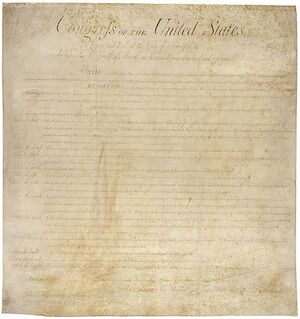United States Bill of Rights (nonfiction): Difference between revisions
(Created page with "The '''Bill of Rights''' is the first ten amendments to the United States Constitution. Proposed following the oftentimes bitter 1787–88 battle over ratification of the U.S...") |
No edit summary |
||
| Line 1: | Line 1: | ||
The '''Bill of Rights''' is the first ten amendments to the United States Constitution. | [[File:Bill_of_Rights.jpg|thumb|The Bill of Rights.]]The '''Bill of Rights''' is the first ten amendments to the United States Constitution. | ||
Proposed following the oftentimes bitter 1787–88 battle over ratification of the U.S. Constitution, and crafted to address the objections raised by Anti-Federalists, the Bill of Rights amendments add to the Constitution: | Proposed following the oftentimes bitter 1787–88 battle over ratification of the U.S. Constitution, and crafted to address the objections raised by Anti-Federalists, the Bill of Rights amendments add to the Constitution: | ||
Revision as of 08:31, 11 December 2016
The Bill of Rights is the first ten amendments to the United States Constitution.
Proposed following the oftentimes bitter 1787–88 battle over ratification of the U.S. Constitution, and crafted to address the objections raised by Anti-Federalists, the Bill of Rights amendments add to the Constitution:
- Specific guarantees of personal freedoms and rights;
- Clear limitations on the government's power in judicial and other proceedings;
- Explicit declarations that all powers not specifically delegated to Congress by the Constitution are reserved for the states or the people.
The concepts codified in these amendments are built upon those found in several earlier documents, including the Virginia Declaration of Rights and the English Bill of Rights 1689, along with earlier documents such as Magna Carta (1215).
On June 8, 1789, Representative James Madison introduced nine amendments to the constitution in the House of Representatives. Among his recommendations Madison proposed opening up the Constitution and inserting specific rights limiting the power of Congress in Article One, Section 9. Seven of these limitations would become part of the ten ratified Bill of Rights amendments.
Ultimately, on September 25, 1789, Congress approved twelve articles of amendment to the Constitution and submitted them to the states for ratification. Contrary to Madison's original proposal that the articles be incorporated into the main body of the Constitution, they were proposed as supplemental additions (codicils) to it.
Articles Three through Twelve were ratified as additions to the Constitution on December 15, 1791, and became Amendments One through Ten of the Constitution. Article Two became part of the Constitution on May 5, 1992, as the Twenty-seventh Amendment.
Article One is technically still pending before the states.
In the News
Fiction cross-reference
Nonfiction cross-reference
External links:
- United States Bill of Rights @ Wikipedia
